Samsung GX-10 Review
Samsung GX-10
Samsung or Pentax, it's a great camera whatever the badge says
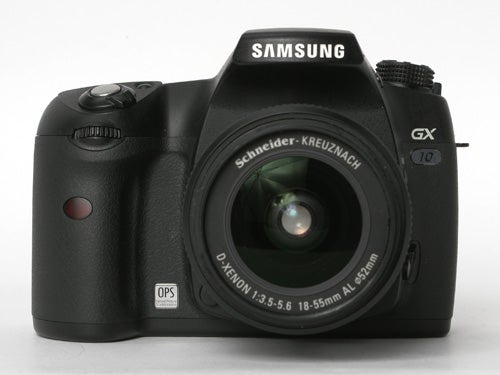
Verdict
Key Specifications
- Review Price: £549.00
It’s a relatively well-known fact that in the camera industry the big profits are in SLR systems rather than compact cameras, which is why all the camera companies have been falling over each other to get consumer-priced digital SLRs into the shops. With the DSLR market expanding by 39 percent in the last year (more than double the growth rate for compacts) and estimated to be worth $1.6 billion by the end of this year, competition has been fierce, and has already seen a couple of casualties; two big well-established camera brands, Konica-Minolta and Kyocera-Contax, have disappeared after decades in the industry. Meanwhile several big electronics companies have muscled their way to the front, eager for a share of a lucrative market dominated by Canon and Nikon. Sony has already succeeded in claiming the third biggest DSLR market share ahead of Pentax and Olympus, based solely on the success of its outstanding debut model the Alpha A100, while Panasonic has used its partnership with Leica to good effect, making some nice high-end kit for the legendary German company, as well as a somewhat less well-received DSLR of its own.

After enjoying something of a renaissance for its compact camera range, Samsung has also found a way into the digital SLR market by re-badging a series of Pentax models. A Samsung representative has assured me that the company will soon launch a DSLR of its own original design, but in the meantime the re-badging tactic provides the company with a bridgehead from which it can build brand familiarity. I’ve already taken a look at the entry-level GX-1L, which started life as the Pentax *ist DL, but this week it’s the turn of Samsung’s latest offering, the GX-10. This is a bit unusual for me, since the GX-10 is a re-badged version of Pentax’s latest top-of-the-range DSLR the K10D, a camera which I have yet to review. I’ve been after Pentax to send me a review sample since the K10D was launched at the end of last year, but Samsung has beaten them to it. I don’t mind too much, since either way I get to play with a nice new camera, but it does mean that I will not be comparing the performance of the two models, since I haven’t handled the Pentax version.
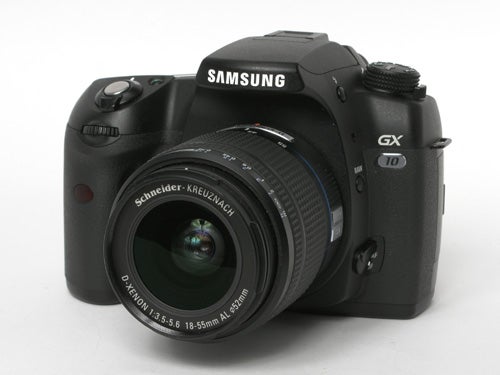
One thing I can compare however is the price. The Samsung GX-10 is currently available for around £550 with an 18-55mm f/3.5-5.6 lens, or £600 as a two-lens kit with the addition of a 50-200mm f/4-5.6. The Pentax K10D on the other hand is £600 for the 18-50mm kit, or £750 for the two lens kit. Bear in mind that the lenses sold with the Samsung version are also Pentax products, re-badged with the Schneider-Kreuznach label, and are identical to those sold with the K10D. The word from those lucky few who have handled both cameras is that the Samsung’s menu system is slightly different, so it’s possible that there are some minor differences in firmware, particularly the Samsung’s use of the Adobe DNG RAW format rather than Pentax’s proprietary PEF RAW file type, and the lack of wireless compatibility with Pentax flash units. There are also some minor cosmetic differences in the body shape and the size of some of the control buttons, but other than that the two cameras are as alike as peas in a pod, so one has to ask, is it worth paying between £50 and £150 extra just for the Pentax name? There may be some slight advantage in second-hand resale value a couple of years down the road, but if Samsung continues to build its reputation as a camera manufacturer even that may be questionable.
So on to the nitty-gritty. The GX-10 is a 10.2-megapixel high-performance digital SLR aimed at the enthusiast or semi-professional photographer. It has a number of advanced features, including built-in moving-sensor shake reduction, a two-part anti-dust system to help keep the CCD clean, a strong weatherproof body with environmental seals on all hatches, a large bright pentaprism viewfinder, 11-point autofocus system and a 22-bit A/D converter. High-speed Samsung DDR2 memory chips give it a fast 3fps continuous shooting speed with no frame limit.
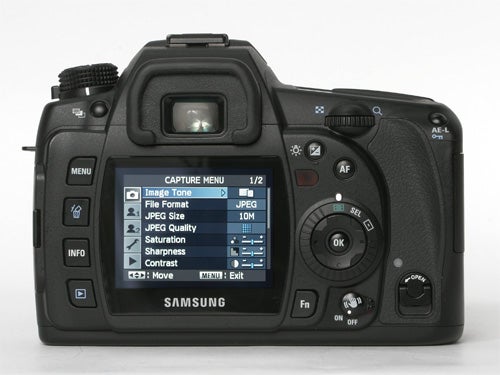
In terms of specification it is hard to compare the GX-10 (or the K10D for that matter) with other manufacturer’s cameras. Perhaps the closest match in terms of price and performance is the Nikon D80, although that camera costs around £680 with an 18-70mm lens and lacks the GX-10’s weatherproof seals. To get another camera that has this feature one has to look at the 12-megapixel Canon EOS 5D, but that costs over £1500 for just the camera body.
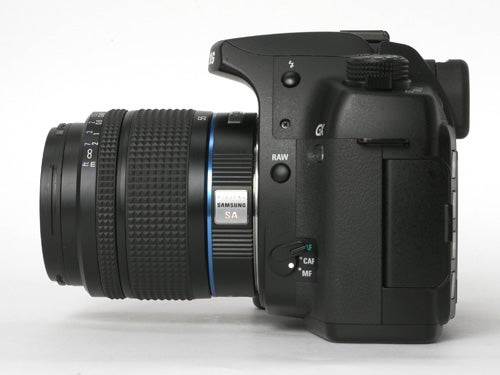
The GX-10 certainly looks the part. It is a very solidly made camera, weighing a hefty 710g without battery or card, and measuring 142 x 101 x 71.5mm, making it 10mm wider and 120g heavier than the D80. The controls are sensibly laid out in a pattern that seems to have become fairly standard for most DSLRs, with the four main interface buttons (which are larger than those on the K10D) on the left of the monitor screen and the D-pad and remaining shooting controls on the right. The main exposure options are set via a tall knurled dial on the top right of the body, with the exposure metering options on a smaller collar beneath it. All the buttons and dials press and turn with a reassuringly positive click, including the two command dials for setting aperture and shutter speed. Many people, myself included, will be pleased to note that the camera has a full-sized backlit LCD data display located on the top panel, instead of using the monitor screen for shooting data like many entry-level SLRs. As I mentioned, the card, battery and connector port hatches all have rubber seals to keep out moisture and dust, and the first two also have secure latches with twist locks to make sure they don’t get opened by accident.
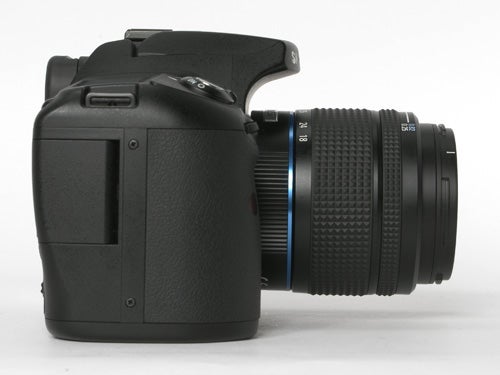
Despite its relatively heavy weight the camera handles superbly. It has a large and extremely comfortable handgrip which I found to be one of the nicest I’ve used. The position of the controls will be instantly familiar to anyone who’s used any other digital SLR, and has obviously benefited from Pentax’s vast experience in camera design. Controls such as AE lock, exposure compensation and AF activation are positioned within easy reach of the right thumb, while the exposure setting dials fall neatly under the thumb and forefinger. I wouldn’t recommend trying to use such a heavy camera one-handed, but it is at least possible.
One handy feature unique to Pentax-designed DSLRs is the “Hyper-program” mode. With the camera set to program exposure, turning the shutter speed or aperture setting command dial overrides the programmed setting, effectively putting the camera into aperture or shutter priority mode, very useful for changing exposure settings on the fly.
Another unique feature is the sensitivity priority setting. In this mode, the user sets the required shutter speed and aperture, and the metering system then sets the ISO sensitivity to produce the correct exposure. The hyper-program feature also operates in this mode, enabling the user to override the selected ISO setting. The range of the selected ISO settings in this and in auto ISO mode can be pre-set by the user in the Fn menu, which is another immensely useful feature.
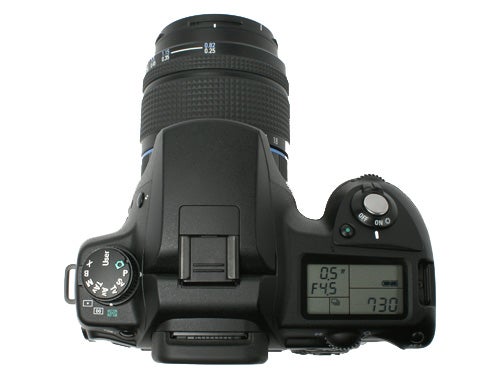
The viewfinder is especially good. Some modern DSLRs have rather small, dark viewfinders, but the GX-10’s pentaprism design is more like the large bright finders found on classic 35mm film SLRs, with 95 percent frame coverage and 95 percent magnification. The 11 target points of the AF system are bright and easy to see even in bright sunlight, and fine lines of the targeting reticule are unobtrusive. There is a fairly complete data display along the bottom frame of the viewfinder, although I did find it a little dim and difficult to read in bright sunlight. Possibly some sort of automatic brightness adjustment would be a good idea?
The LCD monitor is 2.5 inches diagonally, with 210k pixels, not the largest or sharpest around, but it’s certainly sharp and bright enough for image review and menu operation, and has a nice wide angle of view, approximately 140 degrees. If the menu system differs from that used on the K10D then I’d be interested to know which is better, because the Samsung version is very good. There is a separate function button for quick access to drive mode, ISO, white balance and flash mode, and then the large main menu system for everything else.
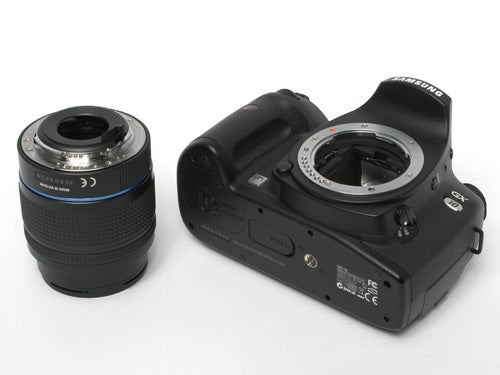
There are eleven menu pages in all, giving control over most aspects of the camera’s operation, from the obvious basics like file format and image size, to the units of the colour temperature dial-in and extended bracketing settings. Picture adjustment parameters include vivid or normal colour, and well as saturation, contrast and sharpness with seven adjustment steps for each, and colour space selection (sRGB or Adobe RGB). If you have a particular set-up that you use a lot, you can save it under the User setting on the main exposure dial. It’s not quite as quick or as versatile as the multiple programmable modes of the Olympus E-400, but it’s enough to cope with most demands, and is not difficult to use. Interestingly the GX-10 also incorporates some features in the playback menu that one wouldn’t normally expect to find in a professional DSLR, including the digital filters previously seen in most Pentax compacts, although thankfully the frame composites have been left out…
Performance is one area in which the GX-10 excels. Like most DSLRs it starts up and shuts down almost instantly, even when the sensor cleaning system is set to operate on startup. The AF system is also very quick, certainly on a par with other high-end DSLRs. The AF sensor system uses 11 focus points, 9 of which have a cross-shaped configuration for quicker and more accurate focusing on certain shapes and textures. Many systems use simpler bar-type focusing sensors, so this is another bonus for the GX-10. I also found that the AF system exceptionally well in low light, in fact even in almost total darkness. The camera has the ability to pulse the pop-up flash to act as an AF assist lamp, but with the exceptional low light ability this feature is almost redundant.
Shooting speed is exceptionally fast. Thanks to its use of high-speed DDR2 memory (the same kind used in high-end gaming PCs) and Pentax’s new PRIME image processing engine the GX-10 can shoot at three frames a second, which is on a par with the Nikon D80, but where the D80’s buffer can only hold 23 shots in JPEG mode or 6 in RAW mode, the GX-10 can shoot 3fps JPEGs continuously until the memory card is full, or a burst of 11 RAW files, although I found that using a faster memory card significantly improved this performance. Using a fast SanDisk Extreme III SD card I was able to keep shooting in RAW mode until the card was full, with only a slight slow-down in shooting speed after the first 11 frames.
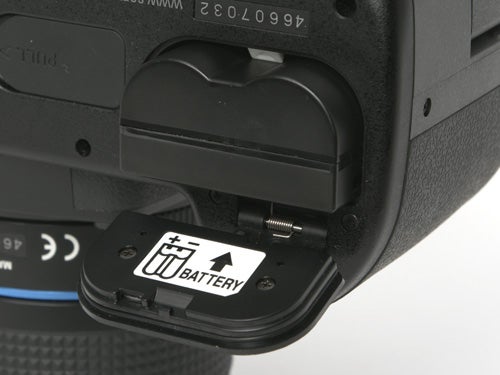
The Adobe DNG RAW files that the GX-10 uses average just over 16MB each, which is quite large for a 10MP camera, almost twice the size of the RAW files recorded by the Nikon D80 or Canon EOS 30D, and even larger than those of the Nikon D200. JPEG files however are surprisingly small, averaging only around 3MB for a typical scene. This indicates quite a lot of JPEG compression, so using RAW mode is obviously essential for maximum quality. In JPEG mode a 1GB card is enough for approximately 207 shots, in RAW mode about 60, and in RAW+JPEG mode only 47.
The GX-10 has the ability to shoot multiple exposures, up to nine shots on the same frame, automatically adjusting the exposure as it goes. In this mode shooting is quite a bit slower, shooting at about one frame every 1.3 seconds, so it’s not particularly useful for fast-moving subjects, but it can produce some interesting effects.
In terms of absolute image quality, the GX-10 is on the same level as the models with which it is competing, and as I’ve pointed out before, the differences in image quality between the various 10MP mid-to-high-end cameras are so slight that it’s almost a matter of personal taste as to which one you prefer. To get the best out of it though it’s essential to use the RAW mode. In JPEG mode the high rate of compression produces images that are not as sharp or detailed as native JPEG images from some other 10MP DSLRs. However processing the DNG RAW files in Adobe Camera RAW produces fantastically sharp, superbly detailed images that are well up to professional standards. Like most Pentax DSLRs they have a slight air of softness about them, but respond extremely well to a light touch of unsharp mask. The SMC Pentax lens (whatever the branding says) is the same high quality glass that we’ve seen before on previous cameras such as the *ist D and K100D, and it produces outstanding corner-to-corner sharpness as always. Also as always it produces some barrel distortion at the 18mm end, but not enough to cause a real problem. While the additional colour depth provided by the 22-bit pipeline and PRIME engine doesn’t make much difference in JPEG mode, in RAW mode it provides a huge amount of exposure latitude, enabling a wide range of exposure adjustment in the post-processing phase, more I would say than any competing camera.
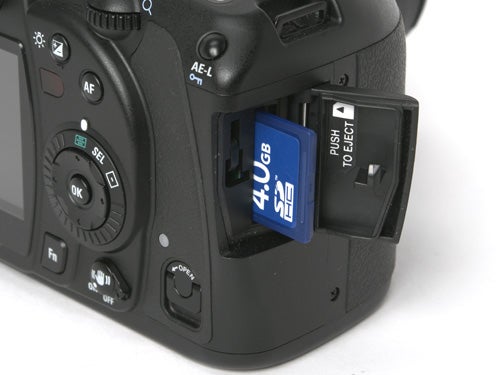
Before I finish however, I must point out one big problem that I discovered when using the GX-10. The camera has a built-in system for keeping dust off the CCD, involving an anti-static coating and a mechanism to vibrate the sensor, in theory shaking any dust particles onto a small sticky strip below the sensor where they will be held out of harms way. The GX-10 that I was lent for review had already been used by somebody else, most likely a reviewer on one of the photography magazines, and whoever it was (I’m looking at you, D) clearly didn’t look after the camera very well. Unfortunately I discovered that there were dust spots on the sensor, and the self-cleaning system did not dislodge them despite several attempts to get it to do so. I’ve had a Sony Alpha A100 SLR for over a year now, a camera which also has a self-cleaning system, and despite regular outdoor use I’ve never had any problem with dust contamination at all, so I can only conclude that either the Pentax/Samsung self cleaning system is not as effective as the Sony one, or that some camera journalists really know how to mess up an otherwise superb camera.
”’Verdict”’
The Samsung GX-10, and presumably by extension the Pentax K10D as well, proves yet again that the digital SLR market isn’t a two-horse race. This camera provides more versatility in its innovative shooting modes, more image quality in its processing engine and faster performance from its high-speed electronics than anything the competition have to offer in this class. Add the rugged durability of the weatherproof body and you have a photographic tool that any keen photographer will quickly learn to love. Just make sure you keep the body cap on when you’re not using it.
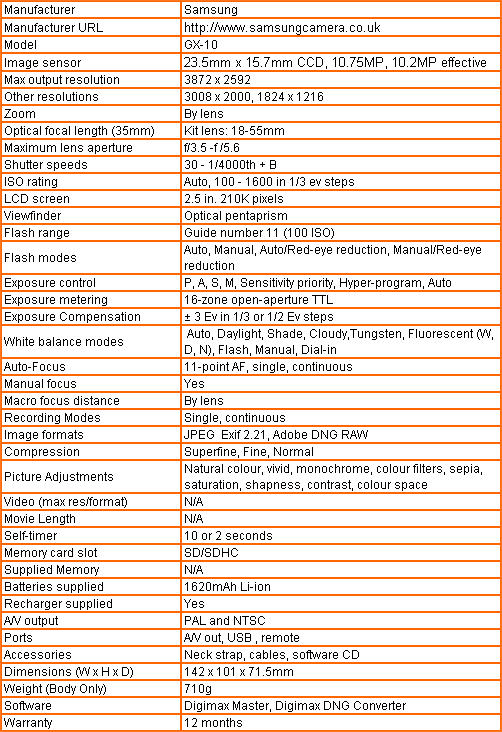
”A range of test shots are shown over the next few pages. Here, the full size image at the minimum ISO setting has been reduced for bandwidth purposes to let you see the full image, and a series of crops taken from original full resolution images at a range of ISO settings have been placed below it in order for you to gain an appreciation of the overall quality.”
—-
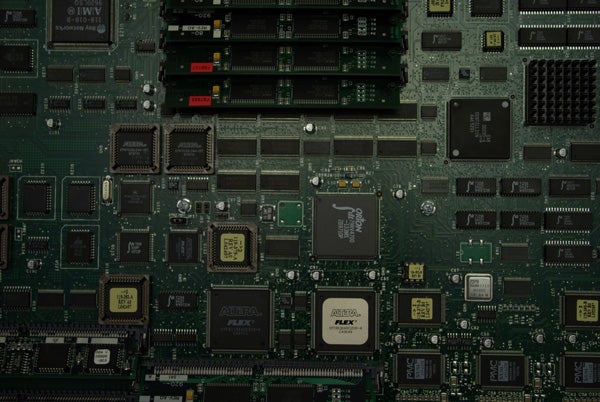
—-
”Note: The GX-10, like many DSLRs, has a wide range of ISO settings, in this case from 100 to 1600 at 1/3 EV intervals. I’ve only shown samples from the main single-EV settings here to save space and loading times.”
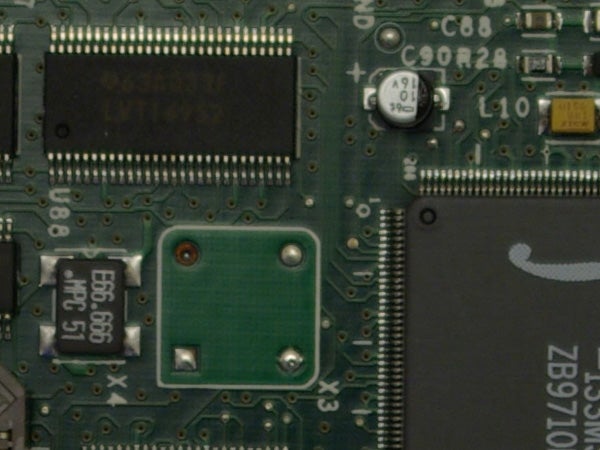
At 100 ISO the GX-10 provides beautifully smooth images with no noise at all, although the characteristic Pentax softness is noticeable.
—-
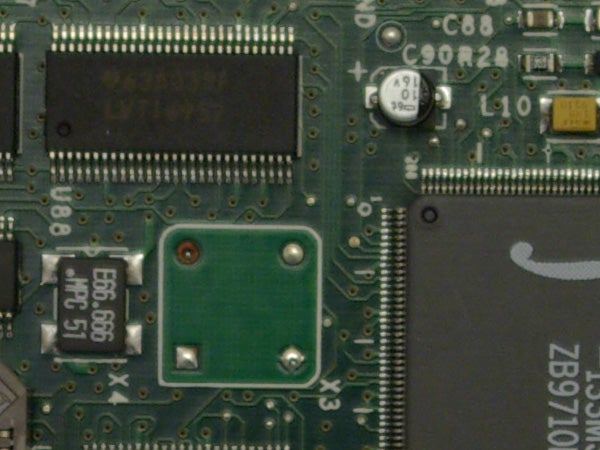
At 200 ISO there is still no image noise visible.
—-
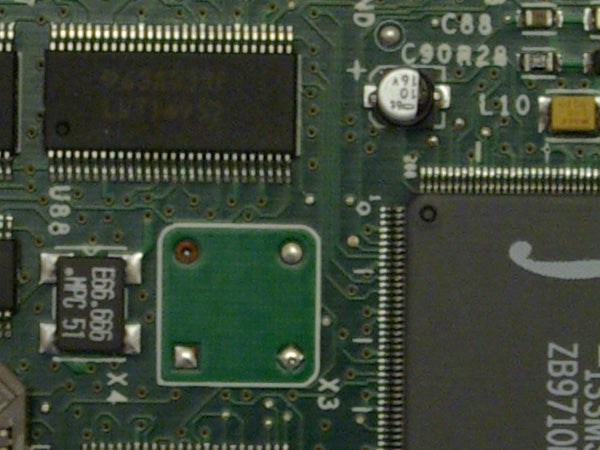
At 400 ISO there is a little colour speckling in the darker areas of the shot.
—-
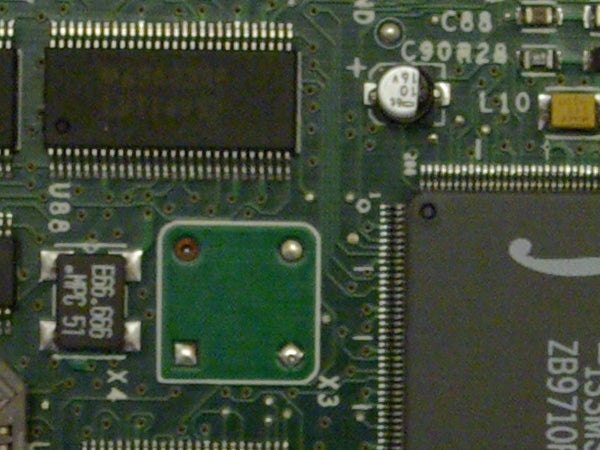
At 800 ISO the colour speckling is more pronounced, and the image is starting to look a bit noisy.
—-
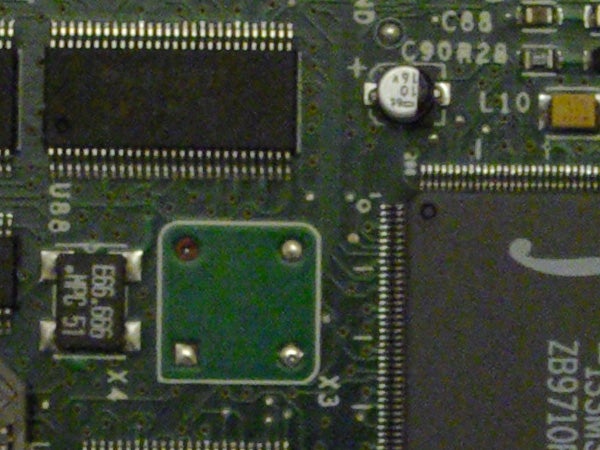
At the maximum 1600 ISO there is a fair bit of image noise visible, but the performance is still well up to the expected standard.
—-
”A range of test shots are shown over the next two pages. Here, the full size image has been reduced for bandwidth purposes, and in some case a crop taken from the original full resolution image has been placed below it in order for you to gain an appreciation of the overall quality.”
—-

As with previous DSLRs that I’ve tested, I shot this image in RAW mode and then converted it to a maximum-quality JPEG using Adobe Camera RAW in Photoshop CS2. See below for a comparison crop at full resolution.
—-

Compare this crop from the above image with similar shots taken on other 10MP DSLRs such as the Olympus E-400, Nikon D80, Canon EOS 400D and others. I think you’ll agree that the GX-10 is as good as any of the competition in terms of overall detail.
—-

The Schneider-Kreuznach-branded Pentax lens produces excellent detail from corner to corner, but slight barrel distortion does bend the horizon a bit. And yes, that’s famously broken ”Napoli” there in the distance, still cluttering up our coastline.
—-

This is a 100-percent crop from the corner of the previous image, showing the level of corner sharpness of the 18-55mm kit lens.
—-

To show the difference in detail and colour depth between the camera’s native high-compression JPEG and the DNG RAW format, take a look at this colourful image. It was shot in JPEG mode.
—-

Here’s a 100-percent crop from the above image.
—-

Now compare it with this crop from the same image, but this time shot in DNG RAW mode and converted using Adobe Camera RAW in Photoshop CS2. The colour gradations are finer, and the shot is noticeably more detailed.
—-
”This page consists of resized images so that you can evaluate the overall exposure.”
—-

In JPEG mode the 22-bit data path doesn’t give much advantage, but in RAW mode it provides greater colour depth and more exposure latitude.
—-

I just had to get a photo of my new car in there somehow, didn’t I? Here it is ably demonstrating the excellent dynamic range available from the RAW mode. The exposure was adjusted in Adobe Camera RAW to bring up a lot of highlight and shadow detail that was simply not visible in JPEG mode.
—-

Shooting at three frames a second you can capture some amazing action shots. This one was done using 15 consecutive frames, then composited together in Photoshop CS2. The guy flying the kite is my good friend Rich Holloway.
—-
Trusted Score
Score in detail
-
Value 10
-
Image Quality 10
Features
| Camera type | Digital SLR |
| Megapixels (Megapixel) | 10.2 Megapixel |
| Optical Zoom (Times) | By lensx |

